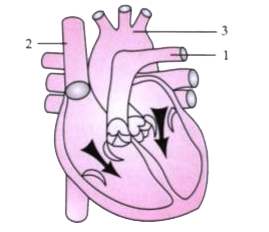Human heart is
Myogenic
Neurogenic
Venous
Both (1) & (2)
The correct Answer is:A
To answer the question "Human heart is...", we need to analyze the options provided: myogenic, neurogenic, venous, and both 1 & 2.
1. Understanding Myogenic and Neurogenic:
- Myogenic: This term refers to the origin of the heartbeat being generated by the muscle itself. In a myogenic heart, the contraction is initiated by specialized muscle cells.
- Neurogenic: This term indicates that the heartbeat is initiated by nerve impulses from the brain or nervous system. In a neurogenic heart, the contraction is triggered by signals from nerves.
2. Identifying the Nature of the Human Heart:
- The human heart is classified as myogenic. This means that the heart's contractions are initiated by the heart muscle itself rather than by nerve signals.
3. Role of the Sinoatrial Node:
- The sinoatrial (SA) node, located in the right atrium of the heart, is responsible for generating electrical impulses that trigger heart contractions. This node has an inherent ability to create a wave of contraction, effectively controlling the heartbeat.
- Because the SA node initiates the contraction of the heart muscle, it is often referred to as the "pacemaker" of the heart.
4. Conclusion:
- Since the human heart's contractions are initiated by the SA node and the muscle itself, we conclude that the human heart is myogenic in nature.
Final Answer:
The human heart is myogenic.
---
- Myogenic: This term refers to the origin of the heartbeat being generated by the muscle itself. In a myogenic heart, the contraction is initiated by specialized muscle cells.
- Neurogenic: This term indicates that the heartbeat is initiated by nerve impulses from the brain or nervous system. In a neurogenic heart, the contraction is triggered by signals from nerves.
- The human heart is classified as myogenic. This means that the heart's contractions are initiated by the heart muscle itself rather than by nerve signals.
- The sinoatrial (SA) node, located in the right atrium of the heart, is responsible for generating electrical impulses that trigger heart contractions. This node has an inherent ability to create a wave of contraction, effectively controlling the heartbeat.
- Because the SA node initiates the contraction of the heart muscle, it is often referred to as the "pacemaker" of the heart.
- Since the human heart's contractions are initiated by the SA node and the muscle itself, we conclude that the human heart is myogenic in nature.
The human heart is myogenic.
Topper's Solved these Questions
- BODY FLUIDS AND CIRCULATIONBOOK - AAKASH INSTITUTE ENGLISHCHAPTER - BODY FLUIDS AND CIRCULATIONEXERCISE - Assignment Section - A Objective Type Questions
32 Videos
- BODY FLUIDS AND CIRCULATIONBOOK - AAKASH INSTITUTE ENGLISHCHAPTER - BODY FLUIDS AND CIRCULATIONEXERCISE - Assignment Section - B Objective Type Questions
30 Videos
- BODY FLUIDS AND CIRCULATIONBOOK - AAKASH INSTITUTE ENGLISHCHAPTER - BODY FLUIDS AND CIRCULATIONEXERCISE - Try Yourself
40 Videos
- BIOTECHNOLOGY-PRINCIPLES AND PROCESSESBOOK - AAKASH INSTITUTE ENGLISHCHAPTER - BIOTECHNOLOGY-PRINCIPLES AND PROCESSESEXERCISE - ASSIGNMENT SECTION-D (Assertion-Reason Type Question)
10 Videos
- BREATHING AND EXCHANGE OF GASES BOOK - AAKASH INSTITUTE ENGLISHCHAPTER - BREATHING AND EXCHANGE OF GASES EXERCISE - ASSIGNMENT SECTION - D
11 Videos
Similar Questions
Read the following statements (i - iv) about human heart :
(i) Human heart is myogenic and our body has the ability to alter the heart rate , cardiac output but not stroke volume.
(ii) P - wave in ECG marks the atrial systole .
(iii) Adrenal medullary hormones acts on SA node and increases heart rate.
How many statement is/are correct form the above ?
View SolutionHow many among the given statements are Incorrect? All of the nodal tissue in human heart is capable of generating 70 - 75 action potentials in a minute.B. Lymph is devoid of all formed elements of blood.C. Cardiac output is defined as the volume of blood pumped by each ventricle in a cardiac cycle.d Wall of left ventricle is thickest among all four chambers of human heart.
View Solution
Knowledge Check
Which of the following statements (s) regarding the cardiac system is/are correct ?
(i) Human heart is an ectodermal derivative
(ii) Mitral valve guards the opening between the right atrium and left ventricle
(iii) SAN is located on the left upper corner of the right atrium
(iv) Stroke volume × Heart rate = Cardiac output.A(i) onlyB(i) and (ii)C(ii) and (iii)D(iv) only
Human heart has
View SolutionHuman heart has interauricular foramen.
View SolutionHow many double circulations are normally completed by the human heart in one minute
View SolutionHow many double circulations are normally completed by human heart in one minute?
View SolutionThe diagram given below represents the human heart in one phase of its functional activities. Study the same and answer the questions that follow :

Name the phase.
View SolutionThe diagram given below represents the human heart in one phase of its functional activities. Study the same and answer the questions that follow :

Which part of the heart is contracting in this phase ? Give a reason to support your answer
View SolutionWhich one of the following statements is correct about the human circulatory system?
(A) Blood transports only oxygen and not carbon dioxide.
(B) Human heart has five chambers.
(C) Valves ensure that the blood does not flow backwards.
(D) Both oxygen-rich and oxygen-deficient blood gets mixed in the heart.
View Solution
